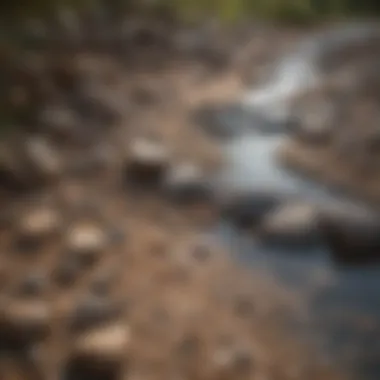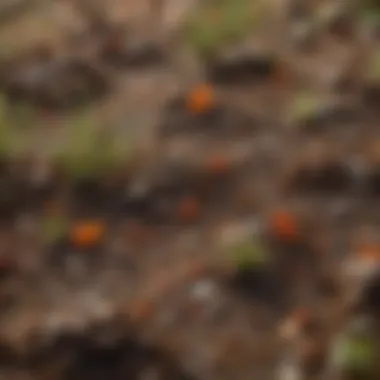Understanding Natural Water Filtration Processes


Nature Topic Overview
Water is vital for all life on Earth. Yet, many people do not understand how nature keeps water clean and safe. This process is known as natural water filtration. Nature has its ways of purifying water through various systems found in ecosystems.
Soil, plants, and microorganisms all play significant roles in this process. They work together to filter out impurities and make water suitable for drinking and other uses. Understanding these processes is important for everyone, especially for young learners.
Through this article, we will explore the different mechanisms of natural filtration. We will learn how each component contributes to maintaining clean water resources. This knowledge can help children value nature and understand the importance of protecting our planet's water supplies.
Fun Facts and Trivia
- Did you know that wetland plants like cattails and reeds can help filter pollutants from water?
- Microorganisms in the soil can consume harmful substances, making the water cleaner.
- Natural filtration systems can be found in habitats like rivers, lakes, and swamps.
Visual aids like diagrams or illustrations can enhance the understanding of these concepts.
Wildlife Explorations
Different species live in environments where natural water filtration takes place. For example, frogs live in ponds that are naturally filtered by plants. When they hop around, they help maintain the ecosystem balance.
- Fish: They rely on clean water for survival. For example, salmon require pure streams to thrive.
- Plants: Water lilies not only provide beauty but also purify water where they grow.
Consider quizzes or puzzles that reveal more about these fascinating relationships.
Environmental Awareness
Conserving nature is crucial for sustaining water resources. Young learners can impact the environment positively. Here are a few simple actions they can take:
- Reduce plastic waste by using reusable containers.
- Participate in local clean-up days to remove trash from waterways.
- Plant native species in gardens to support local ecosystems.
Through these actions, children can help protect nature and ensure clean water for future generations.
DIY Nature Activities
Hands-on activities are a great way to learn about natural water filtration. Here are a few simple experiments:
Water Filter Experiment
- Take a clear plastic bottle and cut it in half.
- Use the top half as a funnel.
- Layer coffee filters, sand, and gravel inside.
- Pour dirty water through the filter and observe how it gets cleaner.
Nature-inspired Craft
- Collect leaves, flowers, and twigs to create a nature collage. This can show how different plants contribute to water filtration.
Outdoor Exploration
- Plan a nature walk to observe local water sources. Encourage children to note the plants and animals found in these areas.
Natural water filtration is a fascinating aspect of nature. Understanding it helps us appreciate the environment and our role in protecting it.
Foreword to Natural Water Filtration
Natural water filtration is an essential process that underpins the quality of water in our ecosystems. It impacts human health and environmental sustainability. Understanding how this filtration works is crucial for preserving clean water sources. When we think about clean water, many may not realize that nature employs various systems to purify it. By absorbing impurities and harmful substances, nature creates a balance necessary for all living beings.
Definition of Water Filtration
Water filtration refers to the process through which water is cleansed of pollutants, sediments, and harmful microorganisms. Natural water filtration happens through complex interactions within ecosystems like soil, plants, and microorganisms.
Some important methods of water filtration include:


- Physical Filtration: Large particles are removed through physical barriers, like soil layers.
- Chemical Filtration: Chemical reactions change harmful substances into less toxic compounds.
- Biological Filtration: Microorganisms consume and break down pollutants.
Importance of Clean Water
Clean water is vital for life. It sustains human health, supports agriculture, and maintains diverse ecosystems. When water is clean, it promotes the growth of plants and animals. Conversely, contaminated water can lead to a range of health problems, impacting people of all ages. In a world facing pollution, the natural filtration systems in place are more important than ever.
"Water is the driving force of all nature." - Leonardo da Vinci
One crucial note about clean water is that everyone has a role in protecting it. Community actions, such as reducing waste and conserving resources, enhance nature’s ability to purify water. Understanding these natural processes can inspire better practices for safeguarding one of our most precious resources.
How Water Travels Through Nature
Understanding how water moves through the environment is essential in grasping the natural filtration processes. The journey of water from its sources to where it can be utilized shows the intricate connections within ecosystems. Recognizing this journey highlights the benefits of natural filtration and the importance of maintaining clean water sources. Moreover, the natural movement of water creates opportunities for purification and recycling, ensuring that ecosystems remain healthy.
The Water Cycle Overview
The water cycle, also known as the hydrological cycle, is the continuous process by which water evaporates, forms clouds, and returns to the earth as precipitation. This cycle is crucial for many reasons:
- It distributes fresh water across the planet, making it accessible to all life forms.
- It helps in regulating temperature and climate.
- It supports various ecosystems by providing essential moisture.
In simple terms, water evaporates from rivers, lakes, and oceans, ascending into the atmosphere. As the water vapor cools, it condenses into droplets, forming clouds. Finally, when the droplets combine and become heavy enough, they fall as rain, snow, or other forms of precipitation. This cycle is not only vital for replenishing water sources but also plays a role in natural filtration.
Surface Runoff and Groundwater Recharge
Surface runoff occurs when water, after a rain event, flows over the ground instead of being absorbed into the soil. This runoff can carry pollutants into rivers and streams. However, it also plays a significant role in recharging groundwater. Here are a few key points:
- Natural Filtration: As water moves over soil and rock, filtering occurs. Soil particles trap sediments and contaminants, allowing cleaner water to percolate downwards.
- Recharge Process: When water moves through the landscape and seeps into the ground, it replenishes aquifers. This groundwater is crucial for drinking water and irrigation, especially in times of drought.
- Environmental Impact: Effective management of surface runoff can prevent flooding, support aquatic habitats, and maintain the balance of natural ecosystems.
Keeping the water cycle functional is vital for both ecosystems and human life. Healthy water movement supports various forms of life and ensures the continuous availability of clean water.
The Role of Soil in Water Filtration
Soil plays a critical role in the natural filtration of water, acting as a barrier that removes contaminants and aids in the purification process. It is essential to understand how different aspects of soil contribute to its filtering capabilities. Different soil types and structures have unique properties making them effective at removing impurities from water while ensuring that it remains suitable for human and ecological needs.
Soil Composition and Structure
The composition of soil consists of minerals, organic matter, water, and air. These elements create a framework that influences how effectively water can be filtered.
- Minerals: Clay, sand, silt, and gravel are the primary components. Clay particles, for example, can hold onto pollutants due to their small size and surface area.
- Organic Matter: This includes decomposed plant materials and microorganisms. It helps improve soil structure and increases its capacity to hold water and nutrients.
- Soil Structure: The way soil particles are arranged affects how water moves through it. Well-structured soil allows for better aeration and water infiltration, leading to more efficient filtration.
The combination of these elements makes soil an effective natural water filter. Understanding the different soil types helps in managing water quality better, since not all soils offer the same filtration capabilities.
Filtration Process in Soil
The process of filtration in soil can be understood through various mechanisms. There are three main processes that work together to purify water: physical filtration, chemical filtration, and the activity of soil microorganisms.
Physical Filtration
Physical filtration refers to the mechanical process of removing particles from water. When water travels through soil, larger particles, such as sand grains, can block smaller contaminants from passing through. The key characteristic of physical filtration is its effectiveness in reducing turbidity and suspended solids.
- Key Benefits: This method is straightforward, as it relies on the natural movement of water, which means it does not require additional energy sources.
- Unique Feature: The structure of the soil allows it to trap different sized particles.
- Advantages: It is cost-effective and naturally occurs in the environment.
- Disadvantages: Over time, physical filtration can become less effective as soil pores get clogged with particles, leading to decreased water flow.
Chemical Filtration
Chemical filtration involves the interaction between soil and dissolved substances in water. Certain minerals in soil can chemically react with contaminants, breaking them down or neutralizing their harmful effects.
- Key Characteristic: The ability of soil to adsorb nutrients and pollutants is critical for this process.
- Unique Feature: Soils rich in clay and organic materials tend to perform better in chemical filtration.
- Advantages: This method can effectively remove toxic substances, making it important for maintaining water quality.
- Disadvantages: The efficiency of chemical filtration can be affected by soil pH and moisture conditions, which may vary over time.
Biodiversity of Soil Microorganisms


Soil is home to a vast range of microorganisms, including bacteria, fungi, and protozoa. These organisms play a vital role in the water filtration process by breaking down organic materials and contaminants. They contribute to the biochemical processes that are essential for natural purification.
- Key Characteristic: The diversity of microorganisms means that various contaminants can be degraded using different biochemical pathways.
- Unique Feature: Some microorganisms can even adapt to the presence of pollutants, providing resilience in different environmental conditions.
- Advantages: They enhance the nutrient cycling in soil which benefits plant growth, thus improving overall ecosystem health.
- Disadvantages: However, drastic changes in pollution levels may disrupt these communities, leading to reduced filtration efficiency.
"Soil is not just dirt; it is an active participant in the water filtration process that directly influences our water quality and ecosystem health."
By appreciating these elements, we can better manage and protect our natural water resources.
The Role of Vegetation in Filtering Water
Vegetation plays a crucial part in the natural water filtration process. Plants not only absorb water but also aid in improving water quality. Their presence in ecosystems contributes to a host of filtration mechanisms that remove contaminants and provide cleaner water for both wildlife and human consumption.
How Plants Absorb Water
Plants absorb water through their roots. The process is essential for their growth and survival. Water enters the plant through tiny root hairs, which increase the surface area for absorption. Once inside, water travels up the plant through a system of vessels called xylem. This movement helps bring nutrients from the soil up to the leaves, where photosynthesis occurs. Plants require consistent access to clean water to thrive. When they have it, they can further purify the water in their environment.
Root Systems and Water Purification
Root systems are not uniform and vary by species. Some plants have deep taproots, while others have shallow, fibrous roots. These root structures can effectively filter out sediments and pollutants. The roots can trap particles and slow down water flow, allowing for better filtration. Additionally, roots support beneficial microorganisms. These microorganisms, such as bacteria and fungi, work symbiotically with plants to break down harmful substances.
Watching roots filter water is like observing nature's cleaning crew at work. They assist in breaking down pollutants and improve the overall quality of water.
Wetlands as Natural Filters
Wetlands are prime examples of nature’s impressive filtration abilities. They are areas where land and water meet, including swamps, marshes, and bogs. These ecosystems store large quantities of water and trap sediments. Wetlands function to absorb excess nutrients and pollutants, acting like sponges. When water flows through wetlands, the plant roots and sediments work to purify it.
The diversity of plants in wetlands plays a critical role. Some plants are specifically adapted to absorb heavy metals and other contaminants. Their ability to thrive in waterlogged soils allows these plants to filter substances that would otherwise poison other ecosystems.
"Wetlands are one of the world's most effective natural water filters. Keeping them healthy means cleaner water for all."
In summary, the role of vegetation in filtering water is vital. It encompasses absorption, purification through root systems, and efficiency in wetlands. Each aspect of plant life contributes significantly to maintaining clean and safe water resources.
Microorganisms and Water Filtration
Microorganisms play a significant role in the natural water filtration process. These tiny life forms, which include bacteria, protozoa, and fungi, contribute to the purification of water in various ecosystems. Understanding how they function can help highlight the essential services they provide in maintaining clean water resources.
Their presence in soil and water systems can break down contaminants and enhance water quality. They can transform harmful substances into less harmful forms, making them indispensable in our quest for clean water.
Types of Microorganisms Involved
Microorganisms can be categorized into three main groups based on their roles in water filtration:
- Bacteria: These are the most abundant microorganisms in both soil and water. They play a crucial role in decomposing organic matter and recycling nutrients. Specific species, such as Pseudomonas and Bacillus, can even degrade pollutants like oil and heavy metals.
- Protozoa: These single-celled organisms primarily feed on bacteria and other microorganisms. By controlling bacterial populations, they help maintain a balance within the ecosystem. Some protozoa also contribute to the breakdown of organic material, aiding in the overall filtration process.
- Fungi: These microorganisms are vital in breaking down complex organic matter, such as dead plants and animals. They release enzymes that decompose materials, releasing essential nutrients back into the soil. This process is important for maintaining soil health and water retention.
How Microorganisms Purify Water
Microorganisms purify water through several mechanisms that work together effectively:
- Decomposition: Microorganisms break down organic matter, such as leaves and animal waste. This decomposition process converts harmful compounds into simpler forms. As a result, it helps in reducing the load of organic pollutants in water sources.
- Nutrient Cycling: When microorganisms decompose organic materials, they release nutrients like nitrogen and phosphorus back into the environment. These nutrients are essential for plant life and contribute to the overall health of aquatic ecosystems.
- Bioremediation: Certain microorganisms can remove or neutralize pollutants in contaminated water. For instance, some bacteria can metabolize toxic substances, transforming them into harmless byproducts. This process is particularly effective in environments where pollutants are abundant, such as rivers and lakes polluted by industrial activities.
"Microorganisms are unsung heroes in the quest for clean water."
- Biofilms Formation: Microorganisms can also form biofilms on surfaces in water systems. These biofilms trap sediments and organic matter, assisting in the filtration process. They create a habitat for various aquatic organisms, further improving water clarity and quality.
Overall, the diverse roles of microorganisms in water filtration illustrate their importance. Ensuring the health of microorganism populations in our ecosystems is vital for maintaining clean water sources. Their contribution gives them a prominent place in discussions about natural water filtration.
Impact of Pollution on Natural Water Filtration
Understanding the impact of pollution on natural water filtration is essential. Pollution disrupts the delicate processes that ecosystems use to keep water clean. Without clean water, health and life are at risk. This section will explore the various sources of water pollution and how they challenge natural filtration processes. Understanding these factors can help us protect our environment and ensure the availability of clean water for future generations.


Sources of Water Pollution
Many factors contribute to water pollution. Some common sources include:
- Industrial Waste: Factories often discharge waste into rivers and lakes. This waste can contain harmful chemicals and metals.
- Agricultural Runoff: Pesticides and fertilizers used in farming may wash into nearby water sources during rain. This runoff can introduce toxins and nutrients that upset the balance of ecosystems.
- Sewage and Wastewater: Improperly treated sewage can lead to a high concentration of bacteria and viruses in water supplies. This can lead to serious health risks for humans and wildlife.
- Plastic Waste: Litter and plastic pollution in oceans and other bodies of water disrupt natural habitats and block filtration processes.
- Oil Spills: Oil leakage from ships or factories introduces toxic substances, harming aquatic life and reducing water quality.
Pollution can come from both urban and rural areas, affecting various ecosystems. Each source presents significant hurdles that can compromise the efficiency of natural filtration systems.
Challenges to Natural Filtration Processes
Pollution poses several challenges to the natural water filtration process. Some key issues include:
- Decreased Water Quality: Contaminants can alter the physical and chemical composition of water. This degradation reduces water's suitability for consumption and for wildlife.
- Disruption of Ecosystems: Pollution can cause imbalances within ecosystems, disrupting the relationships between microorganisms, soil, and plants. Healthy interactions are crucial for effective filtration.
- Biodiversity Loss: Many pollutants are harmful to plants and animals. Reductions in biodiversity can weaken ecosystems, resulting in less effective water filtration.
- Resistance to Natural Recovery: Polluted areas may struggle to recover their natural purity. When pollutants build up in the environment, it can take years or even decades for ecosystems to heal.
The interdependence of these challenges shows how pollution continues to threaten natural water filtration systems. If these threats are not addressed, the natural processes that keep waters clean are at serious risk.
The Significance of Natural Water Filtration Systems
Natural water filtration systems are vital for ensuring the quality of water in our ecosystems. These systems provide numerous services that enhance the environment and contribute to the availability of clean water. Understanding their significance invites us to appreciate the delicate balance of nature involved in water purification.
First, natural filtration processes maintain the overall health of ecosystems. Through soil, vegetation, and microorganisms, nature effectively removes harmful substances and microorganisms that could contaminate water. These processes support not just clean water, but also the entire ecosystem's health, which includes various plants and animals that rely on these clean resources.
Furthermore, natural water filtration aids in the prevention of flooding. Vegetated areas, especially wetlands, can absorb excess water during heavy rains, minimizing surface runoff. This flood control enhances the resilience of surrounding areas, protecting both human and wildlife habitats.
Natural filtration is also an economically viable option. Implementing artificial filtration can be costly and energy-intensive. In contrast, relying on established natural systems requires minimal maintenance while providing consistent effectiveness in water purification.
In summary, the significance of natural water filtration systems extends beyond just providing clean water. They play crucial roles in environmental preservation, disaster mitigation, and economic savings. Recognizing and protecting these systems is essential for maintaining healthy and sustainable communities.
Ecosystem Services Supported by Natural Filtration
Natural filtration systems offer several ecosystem services that help sustain life. Here are some key services:
- Water Quality Improvement: As water flows through natural systems, pollutants are filtered out. This improves the overall quality, making it safer for both wildlife and humans.
- Nutrient Cycling: Filtration allows nutrients in the soil to be recycled, which is essential for plant growth and maintaining biodiversity.
- Water Regulation: These systems help regulate water flow, ensuring that there is adequate supply for various ecosystems.
These ecosystem services are interconnected and vital for supporting life on Earth.
Contributing to Biodiversity and Habitat Health
Natural water filtration systems are essential for maintaining biodiversity. Clean water supports a variety of life forms, both above and below the water surface. For instance, clear rivers and lakes provide habitats for fish and amphibians.
Wetlands and marshes are particularly important. They act as sanctuaries for a wide range of species, including migratory birds and other wildlife. Without healthy filtration systems, many of these species would struggle to survive.
In addition, the diverse microorganisms in soil and water play a crucial role. They help decompose organic matter, releasing nutrients back into the environment. This creates a thriving habitat for larger organisms.
Overall, natural water filtration systems contribute significantly to habitat health and biodiversity. Protecting these systems ensures that future generations can enjoy the benefits of clean water and rich ecosystems.
Epilogue
Natural water filtration systems play a vital role in ensuring the availability of clean water resources. Throughout this article, we explored the multifaceted processes that nature employs to purify water. Each component of these natural systems—soil, vegetation, and microorganisms—works in synchrony to create an effective filtering process.
Summary of Natural Filtration Processes
In summary, natural water filtration occurs through various mechanisms:
- Soil Filtration: Water seeps through soil layers, where physical, chemical, and biological processes remove pollutants. The soil's composition and structure influence how effectively it can capture and filter contaminants.
- Vegetation's Role: Plants absorb water through their root systems. This not only helps them grow but also contributes to the purification of the water that enters the ground.
- Microorganisms Involvement: The microorganisms present in the soil and water play crucial roles in breaking down pollutants through biological processes. They digest organic matter and contribute to the overall cleaning of water.
"Natural systems have an innate ability to purify water, supporting both human life and ecosystems."
By understanding these processes, we can appreciate how ecosystems maintain water quality and promote biodiversity.
Importance of Protecting Natural Water Filters
The protection of natural water filtration systems is critical for several reasons:
- Sustainability: Preserving natural filters helps sustain the ecosystems that rely on clean water. These systems are irreplaceable and have taken millennia to develop.
- Biodiversity Conservation: Healthy ecosystems ensure a balanced environment, promoting biodiversity. Protecting natural filters supports various species and maintains ecological balance.
- Human Health: Clean water is essential for human health. By safeguarding natural filtration systems, we can ensure access to safe drinking water and reduce health-related issues caused by pollution.







